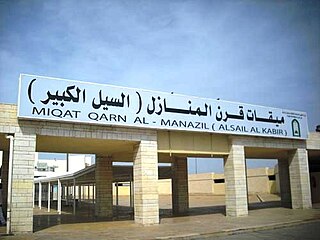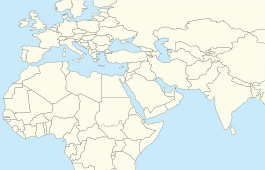
Mecca is the capital of Mecca Province in the Hejaz region of western Saudi Arabia; it is the holiest city according to Islam. It is 70 km (43 mi) inland from Jeddah on the Red Sea, in a narrow valley 277 m (909 ft) above sea level. Its metropolitan population in 2022 was 2.4 million, making it the third-most populated city in Saudi Arabia after Riyadh and Jeddah. Around 44.5% of the population are Saudi citizens and around 55.5% are Muslim foreigners from other countries. Pilgrims more than triple the population number every year during the Ḥajj pilgrimage, observed in the twelfth Hijri month of Dhūl-Ḥijjah. With over 10.8 million international visitors in 2023, Mecca was one of the ten most visited cities in the world.

Medina, officially Al-Madinah al-Munawwarah and also commonly simplified as Madīnah or Madinah, is the capital of Medina Province in the Hejaz region of western Saudi Arabia. It is one of the oldest and most important places in Islamic history. One of the most sacred cities in Islam, the population as of 2022 is 1,411,599, making it the fourth-most populous city in the country. Around 58.5% of the population are Saudi citizens and 41.5% are foreigners. Located at the core of the Medina Province in the western reaches of the country, the city is distributed over 589 km2 (227 sq mi), of which 293 km2 (113 sq mi) constitutes the city's urban area, while the rest is occupied by the Hejaz Mountains, empty valleys, agricultural spaces and older dormant volcanoes.

Mount Arafat is a granodiorite hill about 20 km (12 mi) southeast of Mecca, in the province of the same name in Saudi Arabia. It is approximately 70 m (230 ft) in height, with its highest point sitting at an elevation of 454 metres (1,490 ft).

Mina, nicknamed the "City of the Tents," is a valley located 8 kilometres southeast of the city of Mecca, in the district of Masha'er, Province of Makkah in the Hejazi region Saudi Arabia. Covering an area of approximately 20 km2 (7.7 sq mi), Mina incorporates the tents, the area of Jamarat, and the slaughterhouses just outside the tents.
Muzdalifah is an open and level area near Mecca in the Hejazi region of Saudi Arabia that is associated with the Ḥajj ("Pilgrimage"). It lies just southeast of Mina, on the route between Mina and Arafat.

The Mīqāt Dhu al-Ḥulayfah, also known as Masjid ash-Shajarah or Masjid Dhu al-Hulayfah, is a miqat and mosque in Abyār ʿAlī, Medina, west of Wadi al-'Aqiq, where the final Islamic prophet, Muhammad, entered the state of ihram before performing 'Umrah, after the Treaty of Hudaybiyyah. The mosque is located 7 km SW of the Al-Masjid an-Nabawi and was defined by Muhammad as the miqat for those willing to perform the Hajj or Umrah pilgrimages from Medina. It is the second-largest miqat mosque after the Miqat Qarn al-Manazil in As-Sayl al-Kabir.

The miqat is a principal boundary at which Muslim pilgrims intending to perform the Ḥajj or ʿUmrah must enter the state of iḥrām, a state of consecration in which certain permitted activities are made prohibited.
The Farewell Pilgrimage refers to the one Hajj pilgrimage that Muhammad performed in the Islamic year 10 AH, following the Conquest of Mecca. Muslims believe that verse 22:27 of the Quran brought about the intent to perform Hajj in Muhammad that year. When Muhammad announced this intent, approximately 100,000 of his Sahaba gathered in Medina to perform the annual pilgrimage with him. Muhammad performed Hajj al-Qiran, a type of Hajj in which Umrah and Hajj are performed together. On the 9th of Dhu al-Hijjah, the Day of Arafah, Muhammad delivered the Farewell Sermon atop the Mount Arafat outside Mecca.

The Day of Arafah is an Islamic holiday that falls on the ninth day of Dhu al-Hijjah of the lunar Islamic Calendar. It is the second day of the Hajj pilgrimage and is followed by the holiday of Eid al-Adha. At dawn of this day, Muslim pilgrims will make their way from Mina to a nearby hillside and plain called Mount Arafat and the Plain of Arafat. It was from this site that the Islamic prophet Muhammad gave one of his last sermons in the final year of his life. Some Muslims hold that part of the Quranic verse announcing that the religion of Islam had been perfected was revealed on this day.

The destruction of heritage sites associated with early Islam is an ongoing phenomenon that has occurred mainly in the Hejaz region of western Saudi Arabia, particularly around the two holiest cities of Islam, Mecca and Medina. The demolition has focused on mosques, burial sites, homes and historical locations associated with the Islamic prophet Muhammad, his companions, and many of the founding personalities of early Islamic history by the Saudi government. In Saudi Arabia, many of the demolitions have officially been part of the continued expansion of the Masjid al-Haram at Mecca and the Prophet's Mosque in Medina and their auxiliary service facilities in order to accommodate the ever-increasing number of Muslims performing the pilgrimage (hajj).

The Kaaba, sometimes referred to as al-Ka'ba al-Musharrafa, is a stone building at the center of Islam's most important mosque and holiest site, the Masjid al-Haram in Mecca, Saudi Arabia. It is considered by Muslims to be the Baytullah and is the qibla for Muslims around the world. The current structure was built after the original building was damaged by fire during the siege of Mecca by Umayyads in 683 CE.

Hajj is an annual Islamic pilgrimage to Mecca, Saudi Arabia, the holiest city for Muslims. Hajj is a mandatory religious duty for capable Muslims that must be carried out at least once in their lifetime by all adult Muslims who are physically and financially capable of undertaking the journey, and of supporting their family during their absence from home.

Masjid Al-Taneem is a mosque in the area of Al-Hil, about 5 miles away from the Kaaba, in the neighbourhood of At-Tan'im in Makkah, western Saudi Arabia. It is a boundary of the Ḥaram, therefore pilgrims of Ḥajj and ʿUmrah can put on Iḥram. This mosque is also known as Masjid Aishah, since Aisha bint Abu Bakr, wife of the Islamic prophet Muhammad, had put on her Ihram from this place once.

Masjid al-Haram, also known as the Sacred Mosque or the Great Mosque of Mecca, is considered to be the most significant mosque in Islam. It encloses the vicinity of the Kaaba in Mecca, in the Mecca Province of Saudi Arabia. It is among the pilgrimage sites associated with the Hajj, which every Muslim must perform at least once in their lives if able. It is also the main site for the performance of ʿUmrah, the lesser pilgrimage that can be undertaken any time of the year. The rites of both pilgrimages include circumambulating the Kaaba within the mosque. The Great Mosque includes other important significant sites, such as the Black Stone, the Zamzam Well, Maqam Ibrahim, and the hills of Safa and Marwa.

The Mosque of the Jinn is a mosque in Mecca, Saudi Arabia, located near Jannat al-Mu'alla. It is also known as the Mosque of Allegiance and the Mosque of Guards because the city's guards would patrol up to that point.

Mosque of Al-Ghamamah is one of the oldest mosques in Medina, Saudi Arabia, located in the place believed to be where the Islamic prophet Muhammad performed an Eid prayer in the year 631. It is also narrated that Muhammad offered Salat ul-Istasqa when the city of Madina faced a shortage of rain. For a while, this mosque was closed for daily prayers because of its proximity to the Al-Masjid an-Nabawi. However quite recently it has been reopened for the worshipers for praying. Five times prayers are held in this mosque now with an internal sound system to avoid the clash of sounds from the Prophet's Mosque. The mosque is one of the historical relics of Medina.

Al Jum'ah Mosque is a mosque in Medina, in the Hejazi region of Saudi Arabia. Also known as Masjid Banī Sālim, Masjid Al-Wādī, Masjid Al-Qubayb, and Masjid ʿĀtikah, it is said by the locals to be where the Islamic prophet Muhammad and his companions performed Salatul-Jumu'ah for the first time, during their hijrah (migration) from Mecca to Medina.

Al-Qantara Mosque, also known as Al-Madhoun Mosque or Qabil Mosque, is an abandoned historical mosque from the Ottoman era in the neighbourhood of Al-Mathnah in the city of At-Ta’if, Saudi Arabia.



















